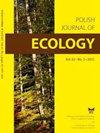Humped Relationship between Herbaceous Species Richness and Biomass Reveals a Potential for Increasing Productivity in a Temperate Desert in Central Asia
IF 0.7
4区 环境科学与生态学
Q4 ECOLOGY
引用次数: 2
Abstract
ABSTRACT Species richness-biomass relationship has become a primary focus in plant community ecology. The most commonly reported pattern of species richness and biomass is the humped relationship with a peak in richness at moderate biomass, although negative, positive, or no relationships exited in some cases. However, the richness-biomass relationship in the temperate deserts of Central Asia, where herbaceous species with different life forms are abundant, remains unclear. In this study, 21–214 plots with herbaceous richness and aboveground biomass for each of four plot sizes (0.25, 25, 100, and 400 m2) were surveyed in early summer and early autumn in the Gurbantunggut Desert, China. Linear and quadratic regressions were employed to examine the richness-biomass relationship and the location of the richness peak. Significantly unimodal species richness-biomass relationships were observed in all plot sizes and seasons (except for 0.25 m2 plot in summer). In most cases (9/11), the biomass at the richness peak was higher than half of the biomass range. Meanwhile, the percent of sampling plots where the biomass was less than the peak was considerably greater than 50% (72.7 to 100%) in all cases, and nine of them were more than 95%, indicating strong interspecific coexistence and weak interspecific competition. In conclusion, under the background of increasing precipitation and nitrogen deposition, the humped richness-biomass relationship and the high percent of sampling plots with low biomass jointly revealed a huge potential for increasing productivity, which is crucial for the carbon fixation and ecosystem stability in deserts of Central Asia.中亚温带沙漠草本物种丰富度与生物量的驼峰关系揭示了提高生产力的潜力
物种丰富度-生物量关系已成为植物群落生态学研究的主要焦点。物种丰富度与生物量最常报道的模式是驼峰关系,在中等生物量时丰富度达到峰值,尽管在某些情况下存在负、正或无关系。然而,在中亚温带沙漠中,不同生命形式的草本物种丰富,其丰富度与生物量的关系尚不清楚。本研究在古尔班通古特沙漠初夏和初秋对4个样地(0.25、25、100和400 m2)的21-214个样地进行了草本丰富度和地上生物量调查。利用线性回归和二次回归分析了丰度与生物量的关系以及丰度峰值的位置。除夏季0.25 m2样地外,所有样地面积和季节物种丰富度与生物量呈显著单峰关系。在大多数情况下(9/11),丰富度峰值处的生物量高于生物量范围的一半。同时,生物量低于峰值的样地所占比例均明显大于50%(72.7 ~ 100%),其中9个样地大于95%,表明种间共存较强,种间竞争较弱。综上所述,在降水和氮沉降增加的背景下,丰富度-生物量的驼峰关系和高比例的低生物量样地共同揭示了中亚沙漠生产力的巨大增长潜力,这对中亚沙漠的碳固定和生态系统稳定至关重要。
本文章由计算机程序翻译,如有差异,请以英文原文为准。
求助全文
约1分钟内获得全文
求助全文
来源期刊

Polish Journal of Ecology
环境科学-生态学
CiteScore
1.10
自引率
0.00%
发文量
9
审稿时长
18-36 weeks
期刊介绍:
POLISH JOURNAL OF ECOLOGY (formerly Ekologia polska) publishes original scientific research papers dealing with all aspects of ecology: both fundamental and applied, physiological ecology, evolutionary ecology, ecology of population, community, ecosystem, landscape as well as global ecology. There is no bias regarding taxons, ecosystems or geographical regions.
 求助内容:
求助内容: 应助结果提醒方式:
应助结果提醒方式:


